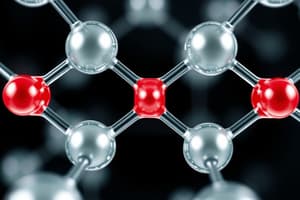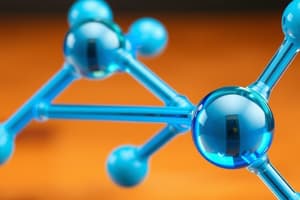Podcast
Questions and Answers
Which type of atoms are involved in covalent bonding?
Which type of atoms are involved in covalent bonding?
- Both metal and non-metal atoms
- Non-metal atoms (correct)
- Noble gas atoms
- Metal atoms
What do atoms share in covalent bonding?
What do atoms share in covalent bonding?
- Electrons (correct)
- Nuclei
- Neutrons
- Protons
What determines the strength of a covalent bond?
What determines the strength of a covalent bond?
- The number of shared electrons and the distance between the nuclei (correct)
- The number of neutrons in the atoms
- The electronegativity of the atoms
- The number of protons in the atoms
What are heteroatomic molecules?
What are heteroatomic molecules?
What do atoms achieve through covalent bonding?
What do atoms achieve through covalent bonding?
Flashcards are hidden until you start studying
Study Notes
Covalent Bonding Overview
- Covalent bonding involves nonmetals or metalloids, typically found on the right side of the periodic table.
- Common atoms involved in covalent bonds include hydrogen (H), carbon (C), nitrogen (N), oxygen (O), fluorine (F), phosphorus (P), and sulfur (S).
Sharing in Covalent Bonding
- Atoms share valence electrons to achieve a stable electronic configuration.
- This sharing can involve single, double, or triple bonds depending on the number of shared electron pairs.
Strength of Covalent Bonds
- The strength of a covalent bond is determined by factors such as bond length, bond order, and the electronegativity of the atoms involved.
- Shorter bonds are generally stronger due to overlapping atomic orbitals, while greater bond order (more shared pairs) also increases bond strength.
Heteroatomic Molecules
- Heteroatomic molecules consist of two or more different types of atoms.
- Examples include water (H₂O) and carbon dioxide (CO₂), where varying elements contribute to unique properties.
Achievements Through Covalent Bonding
- Atoms achieve stability through covalent bonding by completing their valence shells, adhering to the octet rule for many.
- This bonding facilitates the formation of complex structures and molecules, essential for life and various chemical processes.
Studying That Suits You
Use AI to generate personalized quizzes and flashcards to suit your learning preferences.




